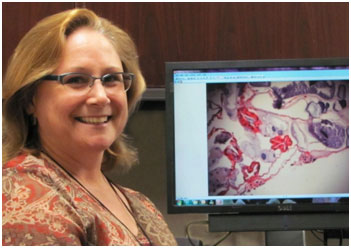Dr. Barbara Drolet is a Research Microbiologist with the USDA, Agricultural Research Service, Arthropod-Borne Animal Diseases Research Unit in Manhattan, KS. Additionally she has Adjunct Professor appointments at the University of Wyoming, Department Veterinary Science and at Kansas State University in the Dept. of Diagnostic Medicine and Pathobiology and in the Dept. of Entomology. She received a B.S. in Microbiology and a M.S. in Pathobiology at the University of Wyoming, and received a Ph.D. in Genetics at Oregon State University. Her current research focuses on developing arboviral immunodiagnostics to investigate molecular interactions of arboviruses and their hosts (mammalian and insect), understanding mammalian immune responses to insect feeding, and the role salivary proteins play in arboviral transmission and pathogenesis. Arthropods of interest include Culicoides biting midges and mosquitoes. Arboviruses of interest include bluetongue, epizootic hemorrhagic disease, vesicular stomatitis, and Rift Valley fever. Projects and publications can be found at https://www.ars.usda.gov/people-locations/person/?person-id=11047.

Virus – Vector – Host Interactions in Vector-Borne Diseases
B. S. Drolet1 and M.K. Mills2
1Arthropod-Borne Animal Diseases Research Unit, USDA, Agricultural Research Service, Manhattan, KS
2Kansas State University, Manhattan, KS
Culicoides sonorensis biting midges transmit several emerging and re-emerging arboviruses of domestic and wild ruminants, including bluetongue virus, epizootic hemorrhagic disease virus (EHDV), and vesicular stomatitis virus (VSV). We have utilized immunohistochemistry (IHC) to examine virus-vector-host interactions in several of these disease systems to better understand vector competence, vector-borne transmission, infection dynamics, and pathogenesis. Conducting a time-course VSV infection in midges, we demonstrated infection, dissemination, and tissue tropism, as well as infection and escape from the critical transmission barriers, namely the midgut and salivary glands. Our results provided the first evidence that this insect species was a competent biological vector of VSV. Most recently we characterized EHDV infection and dissemination within the midge, providing the first look inside the vector to determine the timeline for virus infection and escape from the transmission barriers, thus, determining the transmission window for this known EHDV vector. Although their chitinous exoskeletons and minute size (2mm) make IHC in Culicoides midges quite challenging, it is a powerful tool in the pursuit of understanding vector-borne viral transmission, and often provides critical information for disease epidemiology where other methods prove inadequate.